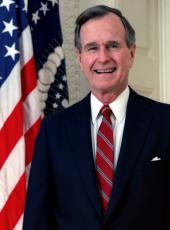Thank you, Mr. Secretary, and thank you especially for your key role in this educational summit. And to all of you, our special guests, welcome to the White House.
Let me first wish a happy birthday to the executive director of the Council for American Private Education, Joyce McCray, who is here someplace. And we have here today the proud representatives of 218 secondary schools -- America's best. And some are private, some are religiously affiliated, some are public -- a mixture of middle, junior, and senior high schools from 42 States, the District of Columbia, and Puerto Rico. But you all have one thing in common: a determination to excel. And I am especially impressed by the 22 schools receiving this award for the second time. You did not take your first win as a reason to relax; you took it as a mandate for continued success. And this clearly shows that all the schools here today have a commitment to quality that is unwavering and true.
And so, returning from the summit, Barbara and I just wanted to say congratulations to all of you. As you know, this was a historic summit on education with the Nation's Governors there in Charlottesville. And one of the first points that we all agreed on was the need for schools and communities to work together. And this is what Douglas Molzahn of Lincoln High in Manitowoc, Wisconsin, meant when he said that this honor is not a spotlight on his school but a floodlight on his whole community.
Every school here today represents a successful community of businessmen, businesswomen, civic groups, and parents. And no one had to tell you how to do this -- not Washington, not your State government. You set your own high goals and then you met them. These ideas dominated the discussion at this national summit. The Governors and I agreed that education is central to the continued prosperity of our country, so nothing less than an educated work force will do the job. But education has always been and must remain a State responsibility and a local function.
So, for the first time, then, in American history we reached the following agreements: to establish a process for setting national education goals, to seek flexibility and enhanced accountability and the use of Federal resources to meet these goals through both regulation and legislative change, to undertake a major State-by-State effort to restructure our education system, and then to report annually on progress in achieving these goals. I am going to stay engaged and use the bully pulpit of the White House to do my part working with these Governors to achieve educational excellence. By doing this, we will be truly walking in the footsteps of Thomas Jefferson. In fact, we've already started down the path by entering into this new compact, a Jeffersonian compact to enlighten all of America's children.
But let me say it again: No one will impose these goals on your schools. It's up to every community, every principal, every teacher to accept the challenge of national goals. And can it be done, you might ask. Well, yes. In fact, it has been done, in 218 different ways, along 218 different paths to one goal: excellence in education.
America desperately needs every school to match your determination. There are more than 40 million Americans who have never graduated from high school, and there are more than 17 million Americans who cannot read at all. Benjamin Franklin was once asked what was the most pitiful thing in life. And he replied, "A lonesome man on a rainy day who does not know how to read." Because of your schools, thousands of children will never suffer this singular form of loneliness; they will be readers. And they will be accomplished in many subjects, will possess the skills that our changing economy will demand. And there is no secret to the way in which you're achieving this, no secret to your success.
Danford Sakai of Waiakea High School put his academic philosophy in alliteration: commitment, caring, common sense, communication, and courage. And that's what you bring to your schools, your students, and to the future of our great nation.
So, thank you for what you're doing. Keep up the good work. Congratulations, and God bless you all. Thank you very much.
Note: The President spoke at 4:37 p.m. on the South Lawn of the White House following his return from the education summit in Charlottesville, VA. In his remarks, he referred to Secretary of Education Lauro F. Cavazos.
George Bush, Remarks to Participants in the Secondary School Recognition Program Online by Gerhard Peters and John T. Woolley, The American Presidency Project https://www.presidency.ucsb.edu/node/263499


